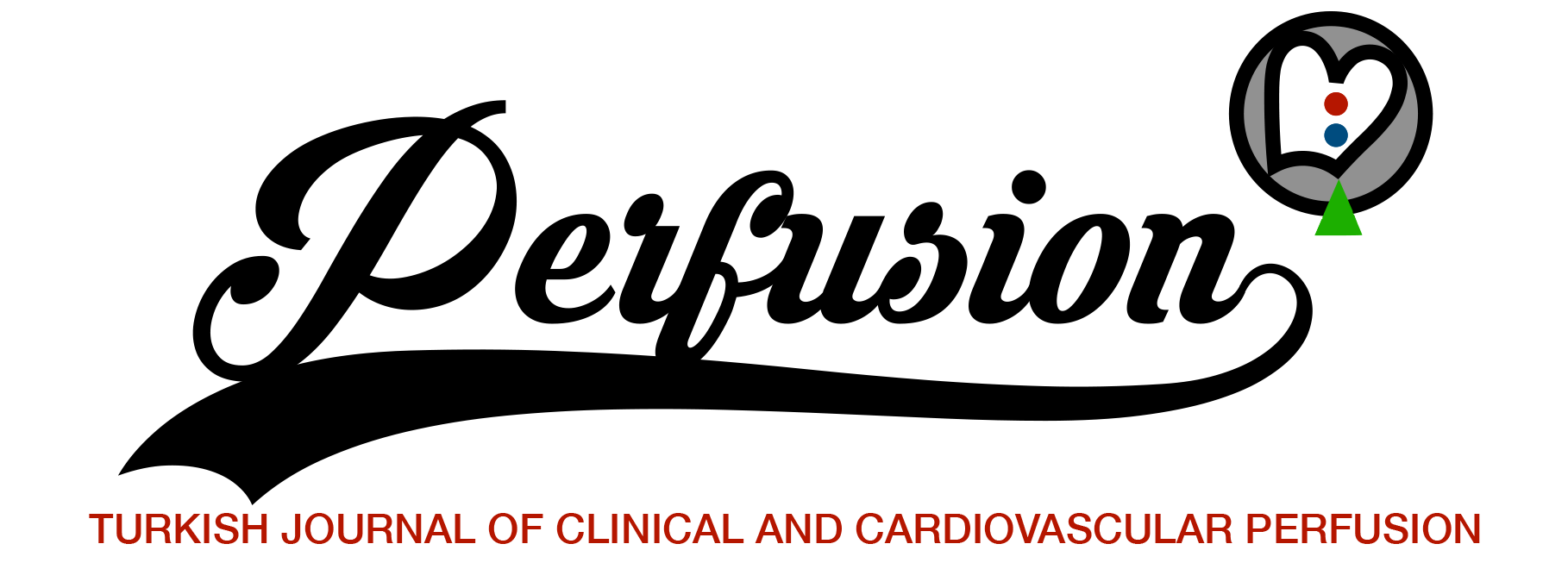ABSTRACT
Objective:
In open heart surgery, blood-preserving autotransfusion systems that centrifuge the aspirated blood and separate the erythrocytes have been frequently used to recirculate the blood accumulated in the surgical area and minimize complications. It is aimed to investigate the hemodynamic, hemostatic, and inflammatory effects of autotransfusion or cardiotomy aspirator use in open heart surgery patients.
Materials and Methods:
In this study, patients who use a cardiotomy reservoir (group 1, n=27) and patients who used autotransfusion (group 2, n=27) in open heart surgery were compared retrospectively. All patients’ demographic characteristics, hemodynamic and laboratory data, operational and postoperative follow-up data were recorded. SPSS Statics 22 program was used for statistical analysis.
Results:
In our study, with the use of autotransfusion, an average of 774 mL of autotransfusion blood was reinfused to the patients and more negative postoperative balance was found compared to the classical cardiotomy aspirator system. Although there was no significant difference in terms of intensive care unit stay of the patients, the duration of ventilation and hospital stay were found to be statistically shorter in the autotransfusion group. There was no statistically significant difference between the groups in terms of hemoglobin, hematocrit, and thrombocyte values, and the use of erythrocyte suspension and fresh frozen plasma. Complications such as hemolysis and infection were not encountered.
Conclusion:
The autotransfusion system should be considered as a safe and effective blood sparing method in patients with low preoperative hemoglobin, rare blood group, or multiple antibodies, especially in major surgeries with high bleeding risk.
Keywords:
Autotransfusion, cardiopulmonary bypass, cell saver, cell salvage
References
1Ashworth A, Klein AA. Cell salvage as part of a blood conservation strategy in anaesthesia. Br J Anaesth 2010;105(4):401-416.
2Svenmarker S, Engström KG. The inflammatory response to recycled pericardial suction blood and the influence of cell-saving. Scand Cardiovasc J 2003;37(3):158-164.
3Yasukawa T, Manabe S, Hiraoka D, Hirayama D, Kinoshita R, Komori M, et al. Safety and efficacy of a simple cardiotomy suction system as a blood salvage procedure during off-pump coronary artery bypass surgery. J Artif Organs 2019;22(3):194-199.
4Sugita J, Fujiu K. Systemic Inflammatory Stress Response During Cardiac Surgery. Int Heart J 2018;59(3):457-459.
5Bauer A, Hausmann H, Schaarschmidt J, Scharpenberg M, Troitzsch D, Johansen P, et al. Shed-blood-separation and cell-saver: an integral Part of MiECC? Shed-blood-separation and its influence on the perioperative inflammatory response during coronary revascularization with minimal invasive extracorporeal circulation systems - a randomized controlled trial. Perfusion 2018;33(2):136-147.
6Damgaard S, Nielsen CH, Andersen LW, Bendtzen K, Tvede M, Steinbrüchel DA. Cell saver for on-pump coronary operations reduces systemic inflammatory markers: a randomized trial. Ann Thorac Surg 2010;89(5):1511-1517.
7Jewell AE, Akowuah EF, Suvarna SK, Braidley P, Hopkinson D, Cooper G. A prospective randomised comparison of cardiotomy suction and cell saver for recycling shed blood during cardiac surgery. Eur J Cardiothorac Surg 2003;23(4):633-636.
8Gäbel J. Hemodynamic, hemostatic and inflammatory effects of cardiotomy suction blood in cardiac surgery. Thesis. University of Gothenburg, Sweden:2013.
9Goel P, Pannu H, Mohan D, Arora R. Efficacy of cell saver in reducing homologous blood transfusions during OPCAB surgery: a prospective randomized trial. Transfus Med 2007;17(4):285-289.
10Vonk AB, Meesters MI, Garnier RP, Romijn JW, van Barneveld LJ, Heymans MW, et al. Intraoperative cell salvage is associated with reduced postoperative blood loss and transfusion requirements in cardiac surgery: a cohort study. Transfusion 2013;53(11):2782-2789.
11Marcoux J, Rosin M, McNair E, Smith G, Lim H, Mycyk T. A comparison of intra-operative cell-saving strategies upon immediate post-operative outcomes after CPB-assisted cardiac procedures. Perfusion 2008;23(3):157-164.
12Sirvinskas E, Veikutiene A, Benetis R, Grybauskas P, Andrejaitiene J, Veikutis V, et al. Influence of early re-infusion of autologous shed mediastinal blood on clinical outcome after cardiac surgery. Perfusion 2007;22(5):345-352.
13Vonk AB, Muntajit W, Bhagirath P, van Barneveld LJ, Romijn JW, de Vroege R, et al. Residual blood processing by centrifugation, cell salvage or ultrafiltration in cardiac surgery: effects on clinical hemostatic and ex-vivo rheological parameters. Blood Coagul Fibrinolysis 2012;23(7):622-628.
14Silva LL, Andres AJ, Senger R, Stuermer R, Godoy MC, Correa EF, et al. Impact of autologous blood transfusion on the use of pack of red blood cells in coronary artery bypass grafting surgery. Rev Bras Cir Cardiovasc 2013;28(2):183-189.
15Damgaard S, Steinbrüchel DA. Autotransfusion with cell saver for off-pump coronary artery bypass surgery: a randomized trial. Scand Cardiovasc J 2006;40(3):194-198.
16Klein AA, Nashef SA, Sharples L, Bottrill F, Dyer M, Armstrong J, et al. A randomized controlled trial of cell salvage in routine cardiac surgery. Anesth Analg 2008;107(5):1487-1495.
17Al-Mandhari S, Maddali MM, Al-Bahrani MJ. Cell salvage during coronary artery bypass surgery and allogenic blood exposure. Asian Cardiovasc Thorac Ann 2015;23(8):913-916.
18Al Khabori M, Al Riyami A, Siddiqi MS, Sarfaraz ZK, Ziadinov E, Al Sabti H. Impact of cell saver during cardiac surgery on blood transfusion requirements: a systematic review and meta-analysis. Vox Sang 2019;114(6):553-565.
19Wang G, Bainbridge D, Martin J, Cheng D. The efficacy of an intraoperative cell saver during cardiac surgery: a meta-analysis of randomized trials. Anesth Analg 2009;109(2):320-330.
20Vieira SD, da Cunha Vieira Perini F, de Sousa LCB, Buffolo E, Chaccur P, Arrais M, et al. Autologous blood salvage in cardiac surgery: clinical evaluation, efficacy and levels of residual heparin. Hematol Transfus Cell Ther 2021;43(1):1-8.
21Halpern NA, Alicea M, Seabrook B, Spungen AM, McElhinney AJ, Greenstein RJ. Cell saver autologous transfusion: metabolic consequences of washing blood with normal saline. J Trauma 1996;41(3):407-415.
22Djaiani G, Fedorko L, Borger MA, Green R, Carroll J, Marcon M, et al. Continuous-flow cell saver reduces cognitive decline in elderly patients after coronary bypass surgery. Circulation 2007;116(17):1888-1895.
23Fourtounas M. Cell saver physics - a review. South Afr J Anaesth Analg 2020;26(6):S49-S54.
24Luque-Oliveros M. Bacteremia in the red blood cells obtained from the cell saver in patients submitted to heart surgery. Rev Lat Am Enfermagem 2020;28:e3337.
25Klein AA, Bailey CR, Charlton AJ, Evans E, Guckian-Fisher M, McCrossan R, et al. Association of Anaesthetists guidelines: cell salvage for peri-operative blood conservation 2018. Anaesthesia 2018;73(9):1141-1150.



